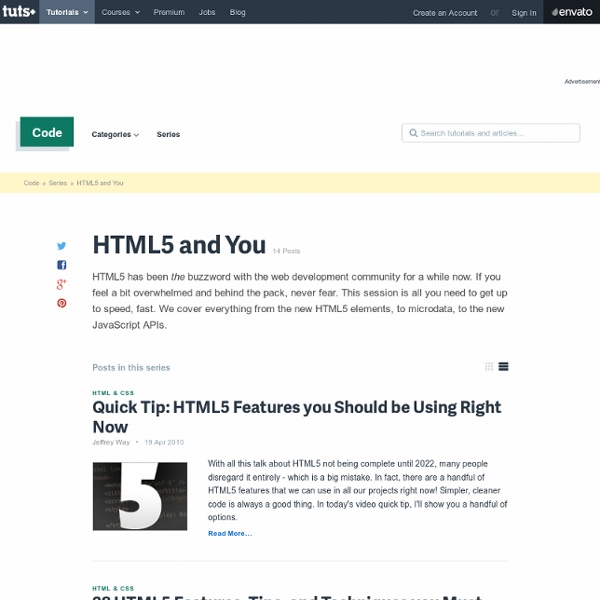



Learning to Love HTML5 - Smashing Magazine Advertisement It seems that new resources and articles for teaching and promoting HTML5 are popping up almost daily. We’ve been given HTML5 templates in the form of the HTML5 boilerplate1 and HTML5 Reset2 (although they both go beyond just HTML5 stuff). We’ve got a plethora of books3 to choose from that cover HTML5 and its related technologies. We’ve got shivs4, galleries5, and a physician6 to help heal your HTML5 maladies. And don’t forget the official spec7. From my own vantage point — aside from a few disputes8 about what the term “HTML5″ should and shouldn’t mean — the web design and development community has for the most part embraced all the new technologies and semantics with a positive attitude. Flickr Photo by Jeremy Keith9 While it’s certainly true that HTML5 has the potential to change the web for the better, the reality is that these kinds of major changes can be difficult to grasp and embrace. The Good (and Easy) Parts An <article> Isn’t Just an Article Section or Article?
HTML5 Presentation In March 1936, an unusual confluence of forces occurred in Santa Clara County. A long cold winter delayed the blossoming of the millions of cherry, apricot, peach, and prune plum trees covering hundreds of square miles of the Valley floor. Then, unlike many years, the rains that followed were light and too early to knock the blossoms from their branches. Instead, by the billions, they all burst open at once. Then came the wind. It roared off the Pacific Ocean, through the nearly uninhabited passes of the Santa Cruz Mountains and then, flattening out, poured down into the great alluvial plains of the Valley. This perfumed blizzard hit Stevens Creek Boulevard, a two-lane road with a streetcar line down its center, that was the main road in the West Valley.
HTML5 A Framework for Ethics in Software Development This is Version 1 of this document. It is a work in progress. There are many points that are not yet addressed and information which is still missing. This document uses Deep Linking. Introduction Why Write This? I have been told many times in recent months, in a variety of contexts, that software developers do not need a code of ethics. A great deal of effort has been put into maintaining a rather misguided status-quo by people who stand to lose a lot of money if things change; namely, the Business Software Alliance, the Motion Picture Association of America, and the Recording Industry Association of America. A near equal amount of effort -- perhaps even more -- has been (albeit less efficiently and effectively) devoted to convincing the public that the ability to copy and modify software with no restrictions is a natural right, by the Free Software Foundation and others. A Note about Laws Assumptions, Silly and Otherwise We need a framework for ethics in software development. References
HTML5 Latest Published Version: Latest Editor's Draft: Previous Versions: Editors: Robin Berjon, W3C Steve Faulkner, The Paciello Group Travis Leithead, Microsoft Erika Doyle Navara, Microsoft Edward O'Connor, Apple Inc. Silvia Pfeiffer Ian Hickson, Google, Inc. This specification is also available as a single page HTML document. Copyright © 2013 W3C® (MIT, ERCIM, Keio, Beihang), All Rights Reserved. This specification defines the 5th major version, first minor revision of the core language of the World Wide Web: the Hypertext Markup Language (HTML). This section describes the status of this document at the time of its publication. If you wish to make comments regarding this document in a manner that is tracked by the W3C, please submit them via using our public bug database. Implementors should be aware that this specification is not stable.
HTML5 Tutorial | HTML 5 Tutorial HTML Font Code Here are some HTML font codes that you can copy/paste straight into your website or MySpace page. Once you've pasted the code, you can change the values as required. The Font Properties When coding HTML, CSS is what you use for formatting. Here are the CSS font/text properties: You can see some of these properties in action below. Quick Example The following font code sets common properties such as font size, line height, font family, and font color. Font Family If you only want to specify the font family, you can use the font-family property: Font Size If you only want to specify the font size, you can use the font-size property. Color If you only want to specify the font color, you can use the color property (more colors): Bold You can make your font bold by using the font-weight property: If you only want to bold some of the text inline, you can use the HTML <span> tag: Italic Text You can make your text italic by using the font-style property: Enjoy this page? Thanks for supporting Quackit!